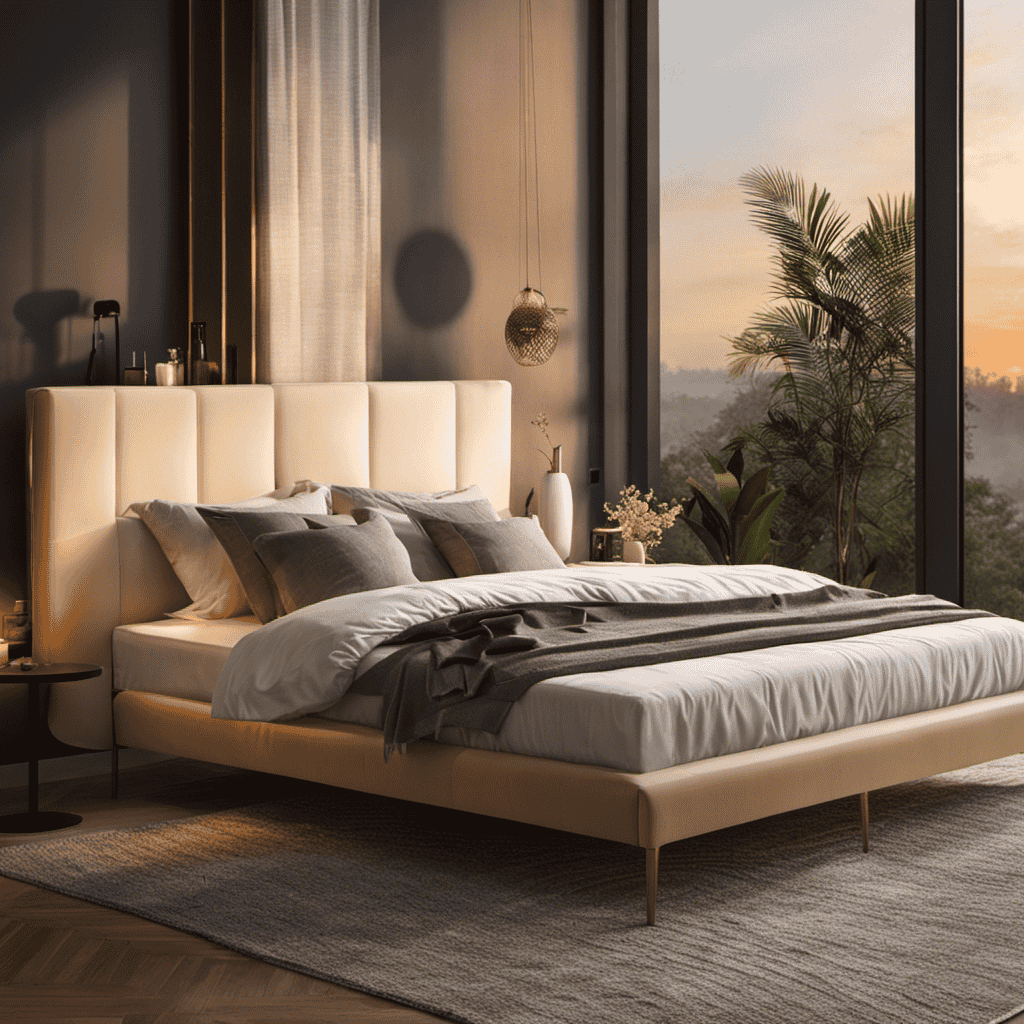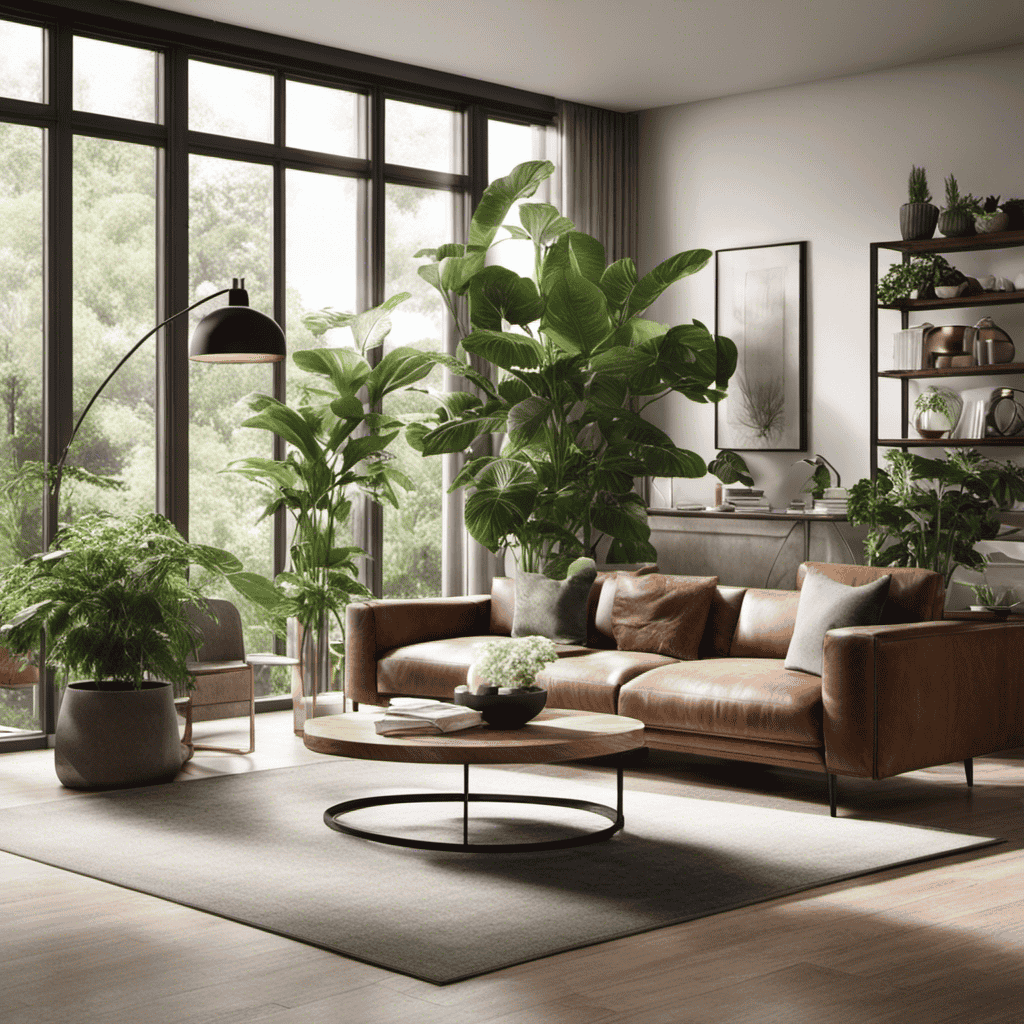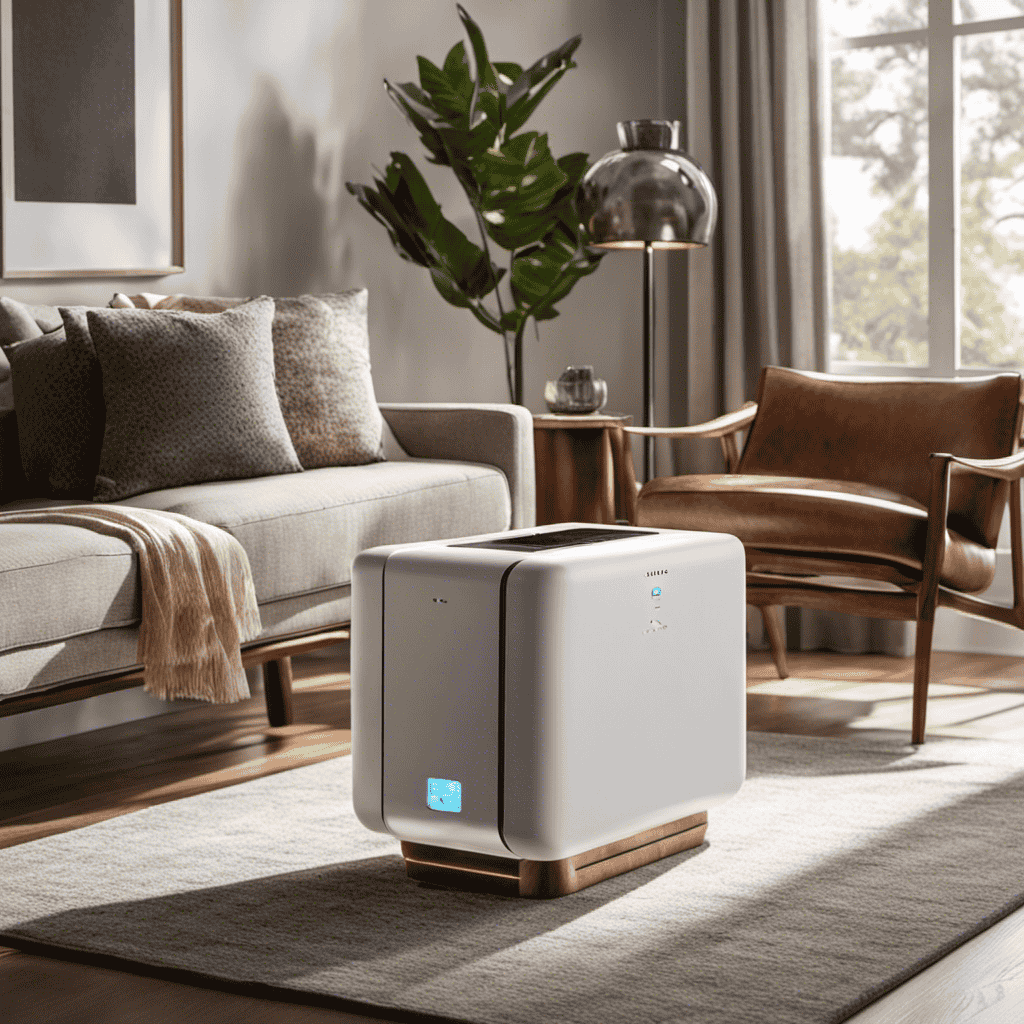I know you may be wondering: ‘When is the optimal time to use an air purifier?’ Let me share with you the results of my research and provide you with the answers.
Whether it’s morning, afternoon, evening, or even nighttime, there’s a perfect time for every situation. And it’s not just about the time of day – I’ll also cover when to use it during pet shedding, renovations, high pollution days, and even when you’re returning from vacation.
So, sit back, relax, and let me guide you through the best practices for running your air purifier.
Key Takeaways
- Running the air purifier in the morning removes allergens and pollutants accumulated overnight
- Fluctuations in air quality can impact energy consumption
- Running the air purifier continuously is the most effective way to remove allergens
- Proper maintenance and regular filter replacement are necessary for optimal performance and clean air
Morning
The best time to run an air purifier in the morning is when you wake up to ensure fresh and clean air throughout the day. Running the air purifier during this time provides optimal morning runtime, allowing it to effectively remove pollutants and allergens that may have accumulated overnight.
By starting the day with purified air, you can breathe easier and improve your overall well-being. Morning air purification benefits extend beyond just clean air; it can also help to reduce morning allergies and alleviate symptoms such as sneezing, congestion, and itchy eyes.
Additionally, running an air purifier in the morning can help to eliminate any odors that may have built up during the night, leaving your home smelling fresh and inviting.
Afternoon
Afternoon is an important time to consider when it comes to running an air purifier. Understanding the optimal purifying hours during the afternoon can significantly improve the overall air quality in your home or office.
Additionally, it is crucial to be aware of the air quality fluctuations that may occur during this time, as it can affect the effectiveness of your air purifier.
Lastly, it is worth considering the impact on energy consumption when running an air purifier during the afternoon, as it can vary depending on the specific model and settings used.
Optimal Purifying Hours
To maximize effectiveness, it’s ideal to run the air purifier during the hours when you’re not using the room.
In the morning, using the air purifier can offer several benefits. First, it helps remove any allergens or pollutants that may have accumulated overnight, ensuring that you start your day with fresh, clean air. Second, running the purifier in the morning can improve your sleep quality by reducing any airborne irritants that could disrupt your sleep. Lastly, the gentle hum of the purifier can create a soothing ambiance, promoting a sense of calm and relaxation as you wake up.
By using the air purifier in the morning, you can enjoy these benefits and start your day feeling refreshed and rejuvenated.
Now, let’s explore how air quality fluctuations can affect the optimal purifying hours.
Air Quality Fluctuations
You should be aware of how air quality fluctuations can impact the effectiveness of your purifier. Monitoring air quality is crucial to ensure that your air purifier is running optimally.
Fluctuations in air quality can occur due to various factors such as outdoor pollution, indoor activities, or even changes in weather patterns. By regularly monitoring the air quality, you can adjust the settings of your purifier accordingly, ensuring that it is working at its best to remove pollutants and allergens from the air.
Additionally, proper maintenance of your air purifier is essential to ensure its effectiveness. Regularly cleaning or replacing filters, checking for any malfunctions, and following manufacturer’s guidelines will help to keep your purifier running efficiently and effectively, providing you with clean and healthy air.
Impact on Energy Consumption?
Fluctuations in air quality can affect how efficiently your purifier operates and impact its energy consumption. When the air quality worsens, the purifier needs to work harder to remove pollutants and maintain clean air. This increased workload can lead to higher energy consumption and ultimately impact your electricity bill.
To minimize the impact on your energy consumption and save on your electricity bill, here are some energy-saving tips:
- Run the purifier during off-peak hours when the electricity rates are lower.
- Use the purifier in the rooms you spend the most time in, rather than running it throughout the entire house.
- Regularly clean or replace the filters to maintain optimal performance and energy efficiency.
Evening
When it comes to nighttime air purification, there are several benefits to using an air purifier in the evening.
First and foremost, the evening is typically a time when we spend a significant amount of time indoors, especially during the colder months. By running an air purifier in the evening, we can ensure that the air we breathe while we sleep is clean and free of pollutants.
Additionally, using an air purifier in the evening can help to reduce allergens and improve overall air quality, leading to better sleep and overall health.
Nighttime Air Purification
At nighttime, it’s best to run your air purifier to improve the air quality while you sleep. The quality of the air we breathe directly affects our sleep and overall health.
Here are some key reasons why running an air purifier at night can provide optimal sleep and health benefits:
-
Eliminates allergens and pollutants: A good air purifier can remove allergens like pollen, dust mites, and pet dander, ensuring you breathe clean air all night.
-
Reduces respiratory issues: By capturing airborne particles, an air purifier helps minimize the risk of respiratory problems, such as asthma or allergies, allowing for better sleep quality.
-
Enhances relaxation: Purifiers with built-in aromatherapy features can release calming scents like lavender, promoting a relaxed state of mind and aiding in falling asleep faster.
Benefits of Evening Use
Now let’s discuss the benefits of evening purification. Running an air purifier in the evening can greatly improve the air quality in your home while you sleep.
During the day, various pollutants, such as dust, allergens, and pet dander, accumulate in the air. By running an air purifier in the evening, you can effectively remove these pollutants, ensuring that you breathe in clean and fresh air throughout the night.
One of the main benefits of nighttime use is improved sleep quality. Breathing in clean air can help reduce snoring, congestion, and improve overall respiratory health, allowing you to wake up feeling more refreshed and energized. Additionally, air purifiers can help eliminate unpleasant odors, creating a more relaxing and comfortable environment for sleep.
Furthermore, evening purification can be especially beneficial for individuals with allergies or asthma. By removing allergens and irritants from the air, air purifiers can help alleviate symptoms and provide relief during the night.
Overall, using an air purifier in the evening offers numerous advantages, promoting a healthier and more restful sleep experience.
Nighttime
You’ll want to consider running your air purifier at nighttime to ensure the cleanest air quality while you sleep. When it comes to nighttime air quality, there are a few key benefits to running your air purifier during this time:
- Improved sleep: By purifying the air in your bedroom while you sleep, you can breathe in cleaner air, which can lead to better sleep quality and overall well-being.
- Allergen reduction: Running your air purifier at night can help to remove allergens such as pollen, dust mites, and pet dander from the air, creating a more comfortable sleeping environment for allergy sufferers.
- Odor elimination: If you have any lingering odors in your bedroom, running an air purifier at night can help to eliminate them, leaving your room smelling fresh and clean.
By running your air purifier at nighttime, you can ensure that you are breathing in the cleanest air possible while you sleep, promoting better sleep quality and overall health.
Now, let’s explore the benefits of running your air purifier all day.
All Day
If you keep your air purifier running all day, you’ll enjoy continuous clean air throughout your home. Running your air purifier all day is the optimal timing for maximum health benefits.
Air purifiers work by capturing and removing airborne particles such as dust, pollen, pet dander, and mold spores. By running it continuously, you ensure that these harmful particles are constantly being filtered out of the air, providing you with cleaner and healthier indoor air quality.
This is especially beneficial for individuals with allergies or respiratory conditions, as it helps minimize exposure to allergens and irritants. Additionally, running the air purifier all day helps maintain a consistent level of air purity and prevents the buildup of pollutants in your home.
During Sleep
While you’re asleep, keeping your air purifier on helps to ensure that you breathe in clean and fresh air throughout the night. This has a significant impact on your sleep quality, as it reduces the presence of allergens, pollutants, and other harmful particles in the air.
Here are three reasons why running an air purifier during sleep is beneficial:
-
Improved Breathing: An air purifier removes airborne irritants, such as dust, pollen, and pet dander. This can alleviate symptoms of allergies, asthma, and other respiratory conditions, allowing you to breathe easier and sleep more soundly.
-
Enhanced Relaxation: Clean air promotes a calm and peaceful environment, facilitating relaxation and reducing stress levels. This can result in a deeper and more restorative sleep, leaving you feeling refreshed and rejuvenated upon waking.
-
Minimized Disruptions: By capturing and eliminating airborne particles, an air purifier helps prevent nighttime disruptions like sneezing, coughing, or itching. This promotes uninterrupted sleep, allowing you to fully recharge and wake up feeling energized.
During Allergy Season
When it comes to optimal air purifier duration during allergy season, it is crucial to understand the effectiveness of allergen removal.
As an expert in air purification, I can confidently say that running an air purifier continuously is the most effective way to remove allergens from the air.
Optimal Air Purifier Duration
The optimal duration to run an air purifier is typically recommended for at least 8 hours a day. This ensures maximum air purifier effectiveness and keeps the air in your home clean and fresh. But when is the best time to run it? Here are some key factors to consider:
-
Nighttime: Running the air purifier while you sleep can help improve your sleep quality by removing allergens and pollutants from the air, allowing you to wake up feeling refreshed.
-
During peak pollution hours: If you live in an area with high pollution levels, running the air purifier during peak hours can help mitigate the effects of outdoor pollutants entering your home.
-
Before and after cleaning activities: Running the air purifier before and after cleaning can help capture dust, pet dander, and other particles that may be stirred up during the cleaning process.
Allergens Removal Effectiveness
To maximize the effectiveness of removing allergens, you should consider running the air purifier for at least 8 hours a day. However, it’s important to understand that the effectiveness of an air purifier can vary depending on the time of day and its placement in your home.
When it comes to morning versus evening effectiveness, it largely depends on the specific allergens you are trying to remove. For example, if pollen is a major concern, running the air purifier in the morning may be more effective as pollen levels tend to be higher during that time. On the other hand, if dust mites or pet dander are the main allergens, running the purifier in the evening when these particles are more likely to be in the air can yield better results.
Additionally, the placement of the air purifier can greatly impact its effectiveness. It is recommended to place the purifier in the room where you spend the most time, such as the bedroom or living room, as this will ensure that the air you breathe in these areas is clean and allergen-free.
During Pollen Season
Running an air purifier during pollen season can help alleviate symptoms caused by allergies. Here are a few reasons why using an air purifier during hay fever can make a significant difference:
-
Relief: Breathing in pollen can trigger sneezing, itching, and congestion. An air purifier can filter out these allergens, providing relief from these symptoms.
-
Improved sleep: Many individuals experience worsened symptoms at night. By running an air purifier while sleeping, you can create a clean and allergen-free environment that promotes better sleep.
-
Long-term benefits: Consistently using an air purifier during pollen season can help reduce the overall allergen load in your home. This can lead to a decrease in symptoms and improve your quality of life.
Transitioning into the next section about ‘during cold and flu season,’ it is equally important to utilize an air purifier to mitigate the spread of airborne viruses and bacteria.
During Cold and Flu Season
Using an air purifier during cold and flu season can help reduce the spread of viruses and bacteria in your home. The air purifier filters out airborne particles, including germs, that can cause illness. When someone in your household is sick, the air purifier can help to remove the viruses and bacteria from the air, preventing them from infecting others.
But it’s not just during cold and flu season that an air purifier can be beneficial. It can also be helpful during summer vacation when your family spends more time indoors, increasing the chances of spreading germs. Additionally, using an air purifier during spring cleaning can help to eliminate dust, pollen, and other allergens that can trigger allergies and respiratory issues.
After Cooking
When it comes to eliminating cooking odors and improving air quality, running an air purifier after cooking is essential. Cooking can release various odors and pollutants into the air, which can linger and affect the overall indoor air quality.
An air purifier equipped with a strong filtration system can effectively remove these odors and particles, ensuring that the air in your home is fresh and clean.
To optimize the purifier’s runtime, it is recommended to run it for a few hours after cooking to thoroughly eliminate any lingering odors and pollutants.
Cooking Odors Eliminated
If you want to get rid of cooking odors, you should try running an air purifier in your kitchen. Air purifiers are effective at eliminating unwanted smells and improving indoor air quality.
Here are some reasons why using an air purifier can be beneficial:
-
Removes cooking odors: Air purifiers have filters that can capture and neutralize particles and odors in the air, including those caused by cooking. This means you can enjoy your delicious meals without having the lingering smell in your kitchen.
-
Improves air quality: Cooking can release pollutants such as smoke, grease, and volatile organic compounds (VOCs) into the air. An air purifier can help remove these harmful particles, ensuring cleaner and healthier air for you and your family.
-
Creates a fresh ambiance: The absence of cooking odors can create a more pleasant and inviting atmosphere in your kitchen. With an air purifier, you can enjoy a fresh and clean space, making your cooking experience even more enjoyable.
Air Quality Improvement
Now that we have discussed how air purifiers can eliminate cooking odors, let’s move on to the importance of air purifier maintenance and filter replacement.
Proper maintenance is key to ensuring that your air purifier continues to perform at its best and provide you with clean air. One crucial aspect of maintenance is regularly cleaning or replacing the air purifier filters. Over time, these filters can become clogged with dust, allergens, and other particles, reducing the purifier’s effectiveness.
It is recommended to clean or replace the filters every three to six months, depending on the manufacturer’s instructions and the air quality in your home. Regular filter replacement will not only improve the air quality in your home but also extend the lifespan of your air purifier.
Optimal Purifier Runtime?
To ensure optimal runtime, it’s important to regularly clean or replace your air purifier filters. By doing so, you can maximize the efficiency of your purifier and enjoy the full purifying benefits it offers.
Here are three reasons why maintaining your air purifier filters is crucial:
-
Improved Indoor Air Quality: Clean filters ensure that the purifier can effectively capture and eliminate pollutants such as dust, pollen, pet dander, and smoke from the air. This leads to cleaner and healthier indoor air, reducing the risk of respiratory issues and allergies.
-
Longer Lifespan: Regular filter maintenance extends the lifespan of your air purifier. When filters are clogged with debris, the purifier has to work harder, putting strain on its components. By keeping the filters clean, you can enhance the longevity of your device and save money in the long run.
-
Optimal Energy Efficiency: Clean filters allow the purifier to operate more efficiently, consuming less energy. This not only benefits the environment but also helps you save on energy costs.
After Cleaning
After cleaning, it’s a good idea to run the air purifier to ensure the air stays fresh and clean. The impact on health cannot be overstated.
Air purifiers help remove harmful pollutants, such as dust, pollen, pet dander, and mold spores, which can cause respiratory issues and allergies. By running the air purifier after cleaning, you can further reduce the presence of these contaminants, creating a healthier indoor environment.
In terms of maintenance requirements, regular cleaning and filter replacement are essential. Cleaning the pre-filter and replacing the HEPA filter, if applicable, will ensure optimal performance and longevity of the air purifier. It’s also important to follow the manufacturer’s instructions for maintenance to keep the unit running efficiently.
Overall, running the air purifier after cleaning is a simple yet effective way to maintain a healthy living space.
During Pet Shedding
When your pet is shedding, it’s important to regularly groom them to minimize fur buildup in your home. During shedding season, pet hair removal becomes a daily task for pet owners like me. Here are some reasons why managing pet shedding is crucial:
-
Less allergens in the air: Excessive pet hair can trigger allergies and respiratory problems, making it difficult to breathe comfortably.
-
Cleaner living environment: By removing pet hair regularly, you can maintain a cleaner and more hygienic home, free from fur floating around.
-
Improved pet comfort: Frequent grooming not only helps remove loose fur but also prevents matting and discomfort for your beloved pet.
To effectively manage pet shedding, invest in a high-quality brush and vacuum cleaner specifically designed for pet hair removal. Regularly groom your pet, ensuring their coat is in good condition, and vacuum your home frequently to keep it fur-free.
During Renovations
During renovations, it’s essential to protect your pet from exposure to dust and harmful chemicals. Construction sites can be hazardous for pets due to the presence of dust particles and chemicals in the air. To ensure the safety and well-being of your furry friend, it is important to implement effective dust control methods during construction. Here are some recommended strategies to minimize your pet’s exposure to dust and harmful substances:
| Dust Control Methods | Benefits |
|---|---|
| Seal off renovation area | Prevents dust from spreading to other parts of the house |
| Use plastic sheeting | Creates a barrier to contain dust and chemicals |
| Ventilate the area | Improves air circulation and reduces dust accumulation |
| Use air purifiers | Filters dust particles and harmful substances from the air |
| Clean regularly | Ensures a clean and safe environment for your pet |
During High Pollution Days
During renovations, running an air purifier is crucial to minimize the impact of dust and debris on indoor air quality. However, there are other times when using an air purifier becomes equally important.
One such instance is during high pollution days. Air pollution, caused by pollutants like particulate matter, ozone, and nitrogen dioxide, can have detrimental effects on our health. Continuous exposure to polluted air can lead to respiratory problems, cardiovascular issues, and even lung cancer.
Here are three sub-lists to highlight the emotional impact of air pollution on health and its long-term effects:
-
Physical discomfort: Constant exposure to polluted air can cause coughing, sneezing, and throat irritation, making it difficult to breathe comfortably.
-
Increased risk of diseases: Long-term exposure to air pollution can increase the risk of developing respiratory diseases, such as asthma and chronic obstructive pulmonary disease (COPD).
-
Reduced quality of life: Living in an area with high pollution levels can limit outdoor activities, affecting mental well-being and overall quality of life.
When Returning From Vacation
As you return from vacation, it’s important to take steps to ensure the air quality in your home is clean and free from pollutants. One way to achieve this is by running an air purifier during your absence. Not only does it help remove dust, pollen, and other allergens from the air, but it also eliminates odors, smoke, and pet dander. This can be especially beneficial for individuals with allergies and asthma, as it reduces their exposure to triggers and improves their symptoms. By using an air purifier during vacation, you can come back to a fresh and purified home environment. Investing in a high-quality air purifier is a wise decision for your overall health and well-being.
| Benefits of running an air purifier during vacation | Impact on allergies and asthma symptoms when using an air purifier during vacation |
|---|---|
| Removes dust, pollen, and allergens | Reduces exposure to triggers |
| Eliminates odors, smoke, and pet dander | Improves symptoms of allergies and asthma |
| Creates a fresh and purified home environment | Enhances overall health and well-being |
Frequently Asked Questions
Can I Run an Air Purifier During the Afternoon if I Have Allergies or Asthma?
I can run an air purifier during the afternoon if I have allergies or asthma. It can help remove allergens and pollutants from the air, providing relief and improving indoor air quality.
Is It Safe to Keep the Air Purifier on All Day and Night?
It’s safe to use an air purifier all day and night. Continuous use ensures consistent air quality and reduces allergens. Remember to clean or replace filters regularly for optimal performance.
Should I Run the Air Purifier During My Sleep?
Running an air purifier during sleep can have numerous benefits. It helps improve the air quality in your bedroom, reducing allergens and pollutants, allowing for a more restful sleep. However, be mindful of the noise it may produce.
How Often Should I Change the Air Filters in My Air Purifier During Allergy Season?
During allergy season, it is important to clean the air filters in your air purifier frequently to ensure optimal performance. Doing so will help remove allergens and improve indoor air quality, providing relief from allergy symptoms.
Can an Air Purifier Help With Pet Allergies Even if My Pet Doesn’t Shed?
Running an air purifier can greatly benefit pet owners with pet dander allergies. Even if your pet doesn’t shed, allergens can still be present in the air. A purifier can help remove these allergens and improve air quality.
Conclusion
In conclusion, after considering various factors, it’s clear that the best time to run an air purifier depends on individual needs and circumstances.
Whether it’s morning, afternoon, evening, or night, choosing the right time can greatly enhance the effectiveness of the device.
Additionally, running an air purifier during pet shedding, renovations, high pollution days, or upon returning from vacation can provide significant benefits.
So, don’t hesitate to make your indoor air quality a priority. Remember, ‘A breath of fresh air can work wonders for your well-being.’










